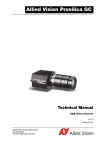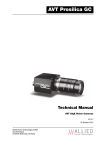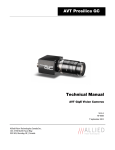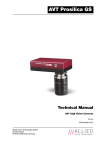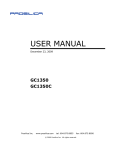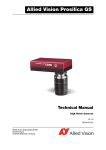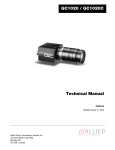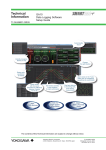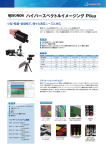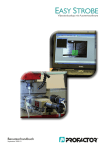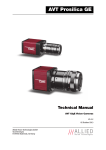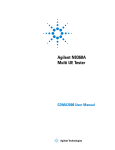Download Prosilica GC1380H Instruction manual
Transcript
AVT Prosilica GC Technical Manual AVT GigE Vision Cameras V2.0.8 26 November 2013 Allied Vision Technologies GmbH Taschenweg 2a D-07646 Stadtroda, Germany Legal notice For customers in the U.S.A. This equipment has been tested and found to comply with the limits for a Class A digital device, pursuant to Part 15 of the FCC Rules. These limits are designed to provide reasonable protection against harmful interference when the equipment is operated in a residential environment. This equipment generates, uses, and can radiate radio frequency energy and, if not installed and used in accordance with the instruction manual, may cause harmful interference to radio communications. However, there is no guarantee that interferences will not occur in a particular installation. If the equipment does cause harmful interference to radio or television reception, the user is encouraged to try to correct the interference by one or more of the following measures: • • • • Reorient or relocate the receiving antenna. Increase the distance between the equipment and the receiver. Use a different line outlet for the receiver. Consult a radio or TV technician for help. You are cautioned that any changes or modifications not expressly approved in this manual could void your authority to operate this equipment. The shielded interface cable recommended in this manual must be used with this equipment in order to comply with the limits for a computing device pursuant to Subpart A of Part 15 of FCC Rules. For customers in Canada This apparatus complies with the Class A limits for radio noise emissions set out in the Radio Interference Regulations. Pour utilisateurs au Canada Cet appareil est conforme aux normes classe A pour bruits radioélectriques, spécifiées dans le Règlement sur le brouillage radioélectrique. Life support applications These products are not designed for use in life support appliances, devices, or systems where malfunction of these products can reasonably be expected to result in personal injury. Allied Vision Technologies customers using or selling these products for use in such applications do so at their own risk and agree to fully indemnify Allied Vision Technologies for any damages resulting from such improper use or sale. Trademarks Unless stated otherwise, all trademarks appearing in this document of Allied Vision Technologies are brands protected by law. Warranty The information provided by Allied Vision Technologies is supplied without any guarantees or warranty whatsoever, be it specific or implicit. Also, excluded are all implicit warranties concerning the negotiability, the suitability for specific applications or the non-breaking of laws and patents. Even if we assume that the information supplied to us is accurate, errors and inaccuracy may still occur. Copyright All texts, pictures and graphics are protected by copyright and other laws protecting intellectual property. It is not permitted to copy or modify them for trade use or transfer, nor may they be used on websites. Allied Vision Technologies GmbH 11/2013 All rights reserved. Managing Director: Mr. Frank Grube Tax ID: DE 184383113 Headquarters: Taschenweg 2a D-07646 Stadtroda, Germany Tel: +49 (0)36428 6770 Fax: +49 (0)36428 677-28 e-mail: [email protected] Prosilica GC Technical Manual V2.0.8 2 Contents Contacting Allied Vision Technologies ................................................... 5 Introduction ............................................................................................................ 6 Document history............................................................................................................ 6 Conventions used in this manual ........................................................................................ 7 Precautions.................................................................................................................... 8 Cleaning optics ............................................................................................................... 9 Conformity ..............................................................................................................11 Specifications .......................................................................................................12 Prosilica GC650/650C..................................................................................................... 12 Prosilica GC655/655C..................................................................................................... 14 Prosilica GC660/660C..................................................................................................... 16 Prosilica GC750/750C..................................................................................................... 18 Prosilica GC780/780C..................................................................................................... 20 Prosilica GC1020/1020C ................................................................................................. 22 Prosilica GC1280 ........................................................................................................... 24 Prosilica GC1290/1290C ................................................................................................. 26 Prosilica GC1350/1350C ................................................................................................. 28 Prosilica GC1380/1380C ................................................................................................. 30 Prosilica GC1380H/1380CH ............................................................................................. 32 Prosilica GC1600/1600C ................................................................................................. 34 Prosilica GC1600H/1600CH ............................................................................................ 36 Prosilica GC2450/2450C ................................................................................................. 38 Camera attribute highlights ........................................................................40 Filter ...........................................................................................................................41 Camera dimensions ..........................................................................................42 Prosilica GC750, GC1280 ................................................................................................. 42 Prosilica GC CCD models: ................................................................................................. 43 Tripod adapter .............................................................................................................. 44 Optical flange focal distance ........................................................................................... 45 Adjustment of C/CS-Mount ............................................................................................. 47 Camera interfaces .............................................................................................48 Status LEDs .................................................................................................................. 48 Gigabit Ethernet port ..................................................................................................... 49 Camera I/O connector pin assignment ............................................................................... 50 I/O definition ............................................................................................................... 51 Prosilica GC Technical Manual V2.0.8 3 Video iris output description............................................................................................ 54 Camera trigger .....................................................................................................55 Camera I/O opto-isolated user circuit example .................................................................... 55 Camera I/O non-isolated user circuit example ..................................................................... 56 Trigger timing diagram................................................................................................... 57 Firmware update .................................................................................................59 Resolution and ROI frame rates ...............................................................60 Prosilica GC650............................................................................................................. 60 Prosilica GC655............................................................................................................. 61 Prosilica GC660............................................................................................................. 61 Prosilica GC750............................................................................................................. 62 Prosilica GC780............................................................................................................. 62 Prosilica GC1020 ........................................................................................................... 63 Prosilica GC1280 ........................................................................................................... 63 Prosilica GC1290 ........................................................................................................... 64 Prosilica GC1350 ........................................................................................................... 64 Prosilica GC1380 ........................................................................................................... 65 Prosilica GC1380H ......................................................................................................... 65 Prosilica GC1600 .......................................................................................................... 66 Prosilica GC1600H ......................................................................................................... 66 Prosilica GC2450 ........................................................................................................... 67 Prosilica GC model comparison ........................................................................................ 68 Description of the data path ........................................................................69 Prosilica GC: monochrome cameras ................................................................................... 69 Prosilica GC: color cameras.............................................................................................. 69 Prosilica GC750C ........................................................................................................... 70 Appendix ..................................................................................................................71 Sensor position of Prosilica GC cameras ............................................................................. 71 Additional references ......................................................................................72 Index...........................................................................................................................73 Prosilica GC Technical Manual V2.0.8 4 Contacting Allied Vision Technologies Contacting Allied Vision Technologies Info • Technical information: http://www.alliedvisiontec.com • Support: [email protected] Allied Vision Technologies GmbH (Headquarters) Taschenweg 2a 07646 Stadtroda, Germany Tel: +49 36428-677-0 Fax: +49 36428-677-28 e-mail: [email protected] Allied Vision Technologies Canada Inc. 101-3750 North Fraser Way Burnaby, BC, V5J 5E9, Canada Tel: +1 604-875-8855 Fax: +1 604-875-8856 e-mail: [email protected] Allied Vision Technologies Inc. 38 Washington Street Newburyport, MA 01950, USA Toll Free number +1 877-USA-1394 Tel: +1 978-225-2030 Fax: +1 978-225-2029 e-mail: [email protected] Allied Vision Technologies Asia Pte. Ltd. 82 Playfair Road #07-02 D’Lithium, Singapore 368001 Tel: +65 6634-9027 Fax: +65 6634-9029 e-mail: [email protected] Allied Vision Technologies (Shanghai) Co. Ltd. 2-2109 Hongwell International Plaza 1602# ZhongShanXi Road, Shanghai 200235, China Tel: +86 21-64861133 Fax: +86 21-54233670 e-mail: [email protected] Prosilica GC Technical Manual V2.0.8 5 Introduction Introduction This AVT Prosilica GC Technical Manual describes in depth the technical specifications of the Prosilica GC camera family including dimensions, feature overview, I/O definition, trigger timing waveforms, and frame rate performance. For information on software installation read the AVT GigE Installation Manual. For detailed information on camera features and controls specific to the Prosilica GC refer to the AVT GigE Camera and Driver Features and AVT GigE Camera and Driver Attributes documents. www AVT Prosilica GC literature: http://www.alliedvisiontec.com/us/support/downloads/ product-literature/prosilica-gc.html Document history Version Date Remarks V2.0.0 2011-Jul-22 New Manual - RELEASE status V2.0.1 2011-Oct-07 Added note to Figure 34 V.2.0.2 2012-Sep-21 • • Renamed Camera IO signals Reworked cleaning optics section V.2.0.3 2013-Jan-14 • • • Updated the exposure control values Updated the Frame rate vs. Height graphs Removed the internal I/O circuit diagram V2.0.4 2013-Mar-26 • • • • Added Status LEDs section Added Appendix Updated the RoHS directive Updated the pixel format naming according to the GenICam naming convention Added caution regarding the drive voltage for the video iris lens on page 54 Added frame rate formulas in the Resolution and ROI frame rates chapter • • V2.0.5 2013-May-07 • • • Updated the exposure control values in the Specifications chapter Added VIMBA SDK link in the Additional references section Updated AVT recommended cabling to Category 6 or higher in the Gigabit Ethernet port section to be continued on next page Table 1: Document history Prosilica GC Technical Manual V2.0.8 6 Introduction Version Date Remarks continued from last page V2.0.6 2013-Jul-05 • Added contact information for Allied Vision Technologies (Shanghai) Co. Ltd. Updated the links to AVT GigE Installation Manual Added links to AVT GigE Camera and Driver Features document • • V2.0.7 2013-Oct-02 • • • • • V2.0.8 2013-Nov-26 • • Added optical flange focal distance and maximum lens protrusion information on page 45 Updated Cleaning optics section Updated vertical binning values in Specifications chapter Updated table 17 on page 40 Updated links for AVT PvAPI SDK Added chapter Description of the data path on page 69 Updated the Index Table 1: Document history Conventions used in this manual To give this manual an easily understood layout and to emphasize important information, the following typographical styles and symbols are used: Styles Style Function Example Bold Programs, inputs, or highlighting important information bold Courier Code listings etc. Input Upper case Register REGISTER Italics Modes, fields Mode Parentheses and/or blue Links (Link) Table 2: Styles Prosilica GC Technical Manual V2.0.8 7 Introduction Symbols Note This symbol highlights important information. Caution www This symbol highlights important instructions. You have to follow these instructions to avoid malfunctions. This symbol highlights URLs for further information. The URL itself is shown in blue. Example: http://www.alliedvisiontec.com Precautions Caution Do not disassemble the camera housing. Warranty is void if camera has been disassembled. This camera contains sensitive internal components. Caution Keep shipping material. Poor packaging of the product may cause damage during shipping. Caution Verify all external connections. Verify all external connections in terms of voltage levels, power requirements, voltage polarity, and signal integrity prior to powering the device. Prosilica GC Technical Manual V2.0.8 8 Introduction Caution Cleaning. This product can be damaged by some volatile cleaning agents. Avoid cleaning the image sensor unless absolutely necessary. Please see instructions on optics cleaning in this document. Caution Do not exceed environmental specifications. See environmental specifications limits in the Specifications section of this document. Special care must be taken to maintain a reasonable operating temperature. If the camera is operated in temperatures higher than the specified range, the camera should be mounted on a heat sink. Cleaning optics Caution Caution AVT does not warranty against any physical damage to the sensor/filter/protection glass or lenses. Use utmost care when cleaning optical components. Do not touch any optics with fingers. Oil from fingers can damage fragile optical coatings. Identifying debris Debris on the image sensor or optical components appears as a darkened area or smudge on a camera image. Do not confuse this with a pixel defect which appears as a distinct point. Locating debris First determine whether the debris is on the sensor glass, IR filter (if used), or lens. The farther away the debris is from the sensor, the blurrier the debris appears on a camera image. Stream a live image from the camera using a uniform target, such as a piece of paper. To determine if the debris is on the camera lens, rotate the lens independent of the camera. If the spot moves, the debris is on the lens. Otherwise, the debris is on the IR filter (if used) or sensor glass. Prosilica GC Technical Manual V2.0.8 9 Introduction Color cameras with IR filter Prosilica GC color cameras are equipped with an IR filter. With no lens or lens cap on a camera, the IR filter is exposed and debris can accumulate on it. This is the most probable location for debris. It should not be necessary to remove the IR filter for cleaning. Clean the outside of the IR filter glass using the techniques explained in the next section. If it is determined that the debris is on the inside surface of the filter glass, or on the sensor glass, IR filter removal is necessary. Depending on the manufacturing date of your Prosilica GC camera, the IR filter may be slot type, or pinhole type. Slot type filters can be removed using a small flat head screw driver. Pinhole type filters require a pin spanner wrench for removal. Note A pin spanner wrench suitable for IR filter removal is available for purchase from AVT. AVT P/N: E9020001 Cleaning with air Blow directly on the contaminated surface with moderate pressure, clean compressed air. Caution Do not exceed 6 bar (90 psi). If using canned air, approximately ~ 4.8 bar (70 psi) when full, do not shake or tilt the can, as extreme changes in temperature due to sudden cold air can crack the optic glass. View a live image with the camera after blowing. If debris is still present, repeat the process until it is determined that the particulate cannot be dislodged. If this is the case, proceed to the contact cleaning technique. Contact cleaning Only use this method if the above air cleaning method does not sufficiently clean the surface. Use 99% pure isopropyl alcohol and clean cotton swabs. Wet the swab in the alcohol. Quickly wipe the optics in a single stroke. Prolonged exposure of alcohol on the swab can cause the swab glue to loosen and transfer to the optic glass. Do not reuse the same swab. Repeat this process until the debris is removed. If this process fails to remove the debris, contact AVT. Prosilica GC Technical Manual V2.0.8 10 Conformity Conformity Allied Vision Technologies declares under its sole responsibility that all standard cameras of the AVT Prosilica GC family to which this declaration relates are in conformity with the following standard(s) or other normative document(s): • CE, following the provisions of 2004/108/EG directive • FCC Part 15 Class A • RoHS (2011/65/EU) We declare, under our sole responsibility, that the previously described AVT Prosilica GC cameras conform to the directives of the CE. Note: This equipment has been tested and found to comply with the limits for a Class A digital device, pursuant to part 15 of the FCC Rules. These limits are designed to provide reasonable protection against harmful interference in a residential environment. This equipment generates radio frequency energy and, if not installed and used in accordance with the instructions, may cause harmful interference to radio communications. Any modifications not expressly approved in this manual may void your authority to operate this equipment. Prosilica GC Technical Manual V2.0.8 11 Specifications Specifications Prosilica GC650/650C Feature Specification Resolution Sensor Type Sensor size Cell size Lens mount Max frame rate at full resolution A/D On-board FIFO Bit depth 659 x 493 Sony ICX424AL, ICX424AQ for color CCD Progressive Type 1/3 7.4 μm C (adjustable) / CS 90 fps 12 bit 16 MB 8/12 GC650: Mono8, Mono12, Mono12Packed GC650C: Mono8 BayerRG8, BayerRG12, BayerGR12Packed, RGB8Packed, BGR8Packed, YUV411Packed, YUV422Packed, YUV444Packed 10 μs to 116.8 s; 1 μs increments 0 to 19 dB 1 to 8 pixels 1 to full resolution 1 input, 1 output 1 input, 1 output 1 5–16 VDC: Cameras SN: 02-XXXXX-0XXXX 5–25 VDC: Cameras SN: 02-XXXXX-1XXXX 3.3 W @ 12 V DC 1.0 μs for non-isolated I/O, 2.8 μs for isolated I/O ±20 ns for non-isolated I/O, ±0.5 μs for isolated I/O 10 ns for non-isolated I/O, 1.3 μs for isolated I/O 0 to +50 °C ambient temperature (without condensation) -10 to +70 °C ambient temperature (without condensation) 20 to 80% non-condensing 59 x 46 x 33 mm including connectors, w/o tripod and lens 104 g IEEE 802.3 1000BASE-T, 100BASE-TX GigE Vision Standard 1.2 CE, FCC Class A, RoHS (2011/65/EU) Mono formats Color formats Exposure control Gain control Horizontal binning Vertical binning TTL I/Os Opto-coupled I/Os RS-232 Power requirements Power consumption Trigger latency Trigger jitter Tpd Operating temperature Storage temperature Operating humidity Body dimensions (L x W x H) Mass Hardware interface standard Software interface standard Regulatory Table 3: Prosilica GC650/650C camera specifications Prosilica GC Technical Manual V2.0.8 12 Specifications 60% Quantum Efficiency 50% 40% 30% 20% 10% 0% 400 500 600 700 800 Wavelength [nm] 900 1000 650 700 Figure 1: Prosilica GC650 monochrome spectral response 40% Red Green 500 550 Wavelength [nm] Blue 35% Quantum Efficiency 30% 25% 20% 15% 10% 5% 0% 400 450 600 Figure 2: Prosilica GC650C color spectral response (without IR cut filter) Prosilica GC Technical Manual V2.0.8 13 Specifications Prosilica GC655/655C Feature Specification Resolution Sensor Type Sensor size Cell size Lens mount Max frame rate at full resolution A/D On-board FIFO Bit depth 659 x 493 Sony ICX414AL, ICX414AQ for color CCD Progressive Type 1/2 9.9 μm C (adjustable) / CS 119 fps 12 bit 16 MB 8/12 Mono formats Color formats Exposure control Gain control Horizontal binning Vertical binning TTL I/Os Opto-coupled I/Os RS-232 Power requirements Power consumption Trigger latency Trigger jitter Tpd Operating temperature Storage temperature Operating humidity Body dimensions (L x W x H) Mass Hardware interface standard Software interface standard Regulatory GC655: Mono8, Mono12, Mono12Packed GC655C: Mono8 BayerRG8, BayerRG12, BayerGR12Packed, RGB8Packed, BGR8Packed, YUV411Packed, YUV422Packed, YUV444Packed 10 μs to 116.8 s; 1 μs increments 0 to 22 dB 1 to 8 pixels 1 to full resolution 1 input, 1 outputs 1 input, 1 outputs 1 5–16 VDC: Cameras SN: 02-XXXXX-0XXXX 5–25 VDC: Cameras SN: 02-XXXXX-1XXXX 3.0 W @ 12 VDC 1.0 μs for non-isolated I/O, 2.8 μs for isolated I/O ±20 ns for non-isolated I/O, ±0.5 μs for isolated I/O 10 ns for non-isolated I/O, 1.3 μs for isolated I/O 0 to +50 °C ambient temperature (without condensation) -10 to +70 °C ambient temperature (without condensation) 20 to 80% non-condensing 59 x 46 x 33 mm including connectors, w/o tripod and lens 105 g IEEE 802.3 1000BASE-T, 100BASE-TX GigE Vision Standard 1.2 CE, FCC Class A, RoHS (2011/65/EU) Table 4: Prosilica GC655/655C camera specifications Prosilica GC Technical Manual V2.0.8 14 Specifications 45% 40% Quantum Efficiency 35% 30% 25% 20% 15% 10% 5% 0% 400 500 600 700 800 Wavelength [nm] 900 1000 650 700 Figure 3: Prosilica GC655 monochrome spectral response Red 35% Green Blue Quantum Efficiency 30% 25% 20% 15% 10% 5% 0% 400 450 500 550 Wavelength [nm] 600 Figure 4: Prosilica GC655C color spectral response (without IR cut filter) Prosilica GC Technical Manual V2.0.8 15 Specifications Prosilica GC660/660C Feature Specification Resolution Sensor Type Sensor size Cell size Lens mount Max frame rate at full resolution A/D On-board FIFO Bit depth 659 x 493 Sony ICX618ALA, ICX618AQ for color CCD Progressive Type 1/4 5.6 μm C (adjustable) / CS 119 fps 12 bit 16 MB 8/12 Mono formats Color formats Exposure control Gain control Horizontal binning Vertical binning TTL I/Os Opto-coupled I/Os RS-232 Power requirements Power consumption Trigger latency Trigger jitter Tpd Operating temperature Storage temperature Operating humidity Body dimensions (L x W x H) Mass Hardware interface standard Software interface standard Regulatory GC660: Mono8, Mono12, Mono12Packed GC660C: Mono8 BayerRG8, BayerRG12, BayerGR12Packed, RGB8Packed, BGR8Packed, YUV411Packed, YUV422Packed, YUV444Packed 10 μs to 78.5 s; 1 μs increments 0 to 34 dB 1 to 8 pixels 1 to 14 rows 1 input, 1 outputs 1 input, 1 outputs 1 5–16 VDC: Cameras SN: 02-XXXXX-0XXXX 5–25 VDC: Cameras SN: 02-XXXXX-1XXXX 3.0 W @ 12 VDC 1.0 μs for non-isolated I/O, 2.8 μs for isolated I/O ±20 ns for non-isolated I/O, ±0.5 μs for isolated I/O 10 ns for non-isolated I/O, 1.3 μs for isolated I/O 0 to +50 °C ambient temperature (without condensation) -10 to +70 °C ambient temperature (without condensation) 20 to 80% non-condensing 59 x 46 x 33 mm including connectors, w/o tripod and lens 105 g IEEE 802.3 1000BASE-T, 100BASE-TX GigE Vision Standard 1.2 CE, FCC Class A, RoHS (2011/65/EU) Table 5: Prosilica GC660/660C camera specifications Prosilica GC Technical Manual V2.0.8 16 Specifications 45% 40% Quantum Efficiency 35% 30% 25% 20% 15% 10% 5% 0% 400 500 600 700 800 900 1000 650 700 Wavelength [nm] Figure 5: Prosilica GC660 monochrome spectral response 80% Red Green 500 550 Blue 70% Quantum Efficiency 60% 50% 40% 30% 20% 10% 0% 400 450 600 Wavelength [nm] Figure 6: Prosilica GC660C color spectral response (without IR cut filter) Prosilica GC Technical Manual V2.0.8 17 Specifications Prosilica GC750/750C Feature Specification Resolution 752 x 480 Sensor Micron MT9V022 Type CMOS Progressive Sensor size Type 1/3 Cell size 6 μm Lens mount CS Max frame rate at full resolution 67 fps A/D 10 bit On-board FIFO 16 MB Bit depth 8/10 Mono formats GC750: Mono8, Mono10 GC750C: Mono8 Color formats BayerBG8, BayerBG10, RGB8Packed, BGR8Packed, RGBA8Packed, BGRA8Packed, YUV411Packed, YUV422Packed, YUV444Packed Exposure control 30 μs to 60 s; 1 μs increments Gain control 0 to 48 dB TTL I/Os 1 input, 1 outputs Opto-coupled I/Os 1 input, 1 outputs RS-232 1 Power requirements 5–16 VDC: Cameras SN: 02-XXXXX-0XXXX 5–25 VDC: Cameras SN: 02-XXXXX-1XXXX Power consumption 2.2 W @ 12 VDC Trigger latency 31 μs for non-isolated I/O, 43 μs for isolated I/O Trigger jitter ±20 ns for non-isolated I/O, ±0.5 μs for isolated I/O Tpd 10 ns for non-isolated I/O, 1.3 μs for isolated I/O Operating temperature 0 to +50 °C ambient temperature (without condensation) Storage temperature -10 to +70 °C ambient temperature (without condensation) Operating humidity 20 to 80% non-condensing Body dimensions (L x W x H) 45 x 46 x 33 mm including connectors, w/o tripod and lens Mass 85 g Hardware interface standard IEEE 802.3 1000BASE-T, 100BASE-TX Software interface standard GigE Vision Standard 1.2 Regulatory CE, FCC Class A, RoHS (2011/65/EU) Table 6: Prosilica GC750/750C camera specifications Prosilica GC Technical Manual V2.0.8 18 Specifications 60% Quantum Efficiency 50% 40% 30% 20% 10% 0% 400 500 600 700 800 Wavelength [nm] 900 1000 650 700 Figure 7: Prosilica GC750 monochrome spectral response 35% Red Green 500 550 Wavelength [nm] Blue Quantum Efficiency 30% 25% 20% 15% 10% 5% 0% 400 450 600 Figure 8: Prosilica GC750C color spectral response (without IR cut filter) Prosilica GC Technical Manual V2.0.8 19 Specifications Prosilica GC780/780C Feature Specification Resolution Sensor Type Sensor size Cell size Lens mount Max frame rate at full resolution A/D On-board FIFO Bit depth Mono formats 782 x 582 Sony ICX415AL, ICX415AQ for color CCD Progressive Type 1/2 8.3 μm C (adjustable) 64 fps 12 bit 16 MB 8/12 GC780: Mono8, Mono12, Mono12Packed GC780C: Mono8 BayerRG8, BayerRG12, BayerGR12Packed, RGB8Packed, BGR8Packed, YUV411Packed, YUV422Packed, YUV444Packed 8 μs to 116.8 s; 1 μs increments 1 to 8 pixels 1 to full resolution GC780: 0 to 26 dB GC780C: 0 to 23 dB 1 input, 1 output 1 input, 1 output 1 5–16 VDC: Cameras SN: 02-XXXXX-0XXXX 5–25 VDC: Cameras SN: 02-XXXXX-1XXXX 2.8 W @ 12 VDC 1 μs for non-isolated I/O, 2.8 μs for isolated I/O ±20 ns for non-isolated I/O, ±0.5 μs for isolated I/O 10 ns for non-isolated I/O, 1.3 μs for isolated I/O 0 to +50 °C ambient temperature (without condensation) -10 to +70 °C ambient temperature (without condensation) 20 to 80% non-condensing 59 x 46 x 33 mm including connectors, w/o tripod and lens 100 g IEEE 802.3 1000BASE-T, 100BASE-TX GigE Vision Standard 1.2 CE, FCC Class A, RoHS (2011/65/EU) Color formats Exposure control Horizontal binning Vertical binning Gain control TTL I/Os Opto-coupled I/Os RS-232 Power requirements Power consumption Trigger latency Trigger jitter Tpd Operating temperature Storage temperature Operating humidity Body dimensions (L x W x H) Mass Hardware interface standard Software interface standard Regulatory Table 7: Prosilica GC780/780C camera specifications Prosilica GC Technical Manual V2.0.8 20 Specifications 45% 40% Quantum Efficiency 35% 30% 25% 20% 15% 10% 5% 0% 400 500 600 700 800 Wavelength [nm] 900 1000 Figure 9: Prosilica GC780 monochrome spectral response 35% Red Green 500 550 Wavelength [nm] Blue Quantum Efficiency 30% 25% 20% 15% 10% 5% 0% 400 450 600 650 700 Figure 10: Prosilica GC780C color spectral response (without IR cut filter) Prosilica GC Technical Manual V2.0.8 21 Specifications Prosilica GC1020/1020C Feature Specification Resolution Sensor Type Sensor size Cell size Lens mount Max frame rate at full resolution A/D On-board FIFO Bit depth 1024 x 768 Sony ICX204AL, ICX204AK for color CCD Progressive Type 1/3 4.65 μm C (adjustable) / CS 33 fps 12 bit 16 MB 8/12 Mono formats GC1020: Mono8, Mono12, Mono12Packed GC1020C: Mono8 BayerRG8, BayerRG12, BayerGR12Packed, RGB8Packed, BGR8Packed, YUV411Packed, YUV422Packed, YUV444Packed 10 μs to 116.8 s; 1 μs increments 0 to 22 dB 1 to 8 pixels 1 to full resolution 1 input, 1 output 1 input, 1 output 1 5–16 VDC: Cameras SN: 02-XXXXX-0XXXX 5–25 VDC: Cameras SN: 02-XXXXX-1XXXX 2.9 W @ 12 VDC 2.8 μs for non-isolated I/O, 4.5 μs for isolated I/O ±20 ns for non-isolated I/O, ±0.5 μs for isolated I/O 10 ns for non-isolated I/O, 1.3 μs for isolated I/O 0 to +50 °C ambient temperature (without condensation) -10 to +70 °C ambient temperature (without condensation) 20 to 80% non-condensing 59 x 46 x 33 mm including connectors, w/o tripod and lens 99 g IEEE 802.3 1000BASE-T, 100BASE-TX GigE Vision Standard 1.2 CE, FCC Class A, RoHS (2011/65/EU) Color formats Exposure control Gain control Horizontal binning Vertical binning TTL I/Os Opto-coupled I/Os RS-232 Power requirements Power consumption Trigger latency Trigger jitter Tpd Operating temperature Storage temperature Operating humidity Body dimensions (L x W x H) Mass Hardware interface standard Software interface standard Regulatory Table 8: Prosilica GC1020/1020C camera specifications Prosilica GC Technical Manual V2.0.8 22 Specifications 50% 45% Quantum Efficiency 40% 35% 30% 25% 20% 15% 10% 5% 0% 400 500 600 700 800 Wavelength [nm] 900 1000 650 700 Figure 11: Prosilica GC1020 monochrome spectral response 35% Red Green 500 550 Wavelength [nm] Blue Quantum Efficiency 30% 25% 20% 15% 10% 5% 0% 400 450 600 Figure 12: Prosilica GC1020C color spectral response (without IR cut filter) Prosilica GC Technical Manual V2.0.8 23 Specifications Prosilica GC1280 Feature Specification Resolution 1280 x 1024 Sensor Cypress IBIS5B Type CMOS Progressive Sensor size Type 2/3 Cell size 6.7 μm Lens mount C (adjustable) Max frame rate at full resolution 27 fps A/D 10 bit On-board FIFO 16 MB Bit depth 8/10 Mono formats Mono8 Exposure control 10 μs to 1 s; 1 μs increments Gain control 0 to 15 dB TTL I/Os 1 input, 1 output Opto-coupled I/Os 1 input, 1 output RS-232 1 Power requirements 5–16 VDC: Cameras SN: 02-XXXXX-0XXXX 5–25 VDC: Cameras SN: 02-XXXXX-1XXXX Power consumption 2.9 W @ 12 VDC Trigger latency 2.8 μs for non-isolated I/O, 4.5 μs for isolated I/O Trigger jitter ±20 ns for non-isolated I/O, ±0.5 μs for isolated I/O Tpd 10 ns for non-isolated I/O, 1.3 μs for isolated I/O Operating temperature 0 to +50 °C ambient temperature (without condensation) Storage temperature -10 to +70 °C ambient temperature (without condensation) Operating humidity 20 to 80% non-condensing Body dimensions (L x W x H) 59 x 46 x 33 mm including connectors, w/o tripod and lens Mass 99 g Hardware interface standard IEEE 802.3 1000BASE-T, 100BASE-TX Software interface standard GigE Vision Standard 1.2 Regulatory CE, FCC Class A, RoHS (2011/65/EU) Table 9: Prosilica GC1280 camera specifications Prosilica GC Technical Manual V2.0.8 24 Specifications 0.18 QE 30% QE 20% 0.16 Spectral response [A/W] 0.14 0.12 0.1 QE 10% 0.08 0.06 0.04 0.02 0 400 500 600 700 800 Wavelength [nm] 900 1000 Figure 13: Prosilica GC1280 monochrome spectral response Prosilica GC Technical Manual V2.0.8 25 Specifications Prosilica GC1290/1290C Feature Specification Resolution Sensor Type Sensor size Cell size Lens mount Max frame rate at full resolution A/D On-board FIFO Bit depth 1280 x 960 Sony ICX445ALA, ICX445AQA for color CCD Progressive Type 1/3 3.75 μm C (adjustable) / CS 32 fps 12 bit 16 MB 8/12 Mono formats GC1290: Mono8, Mono12, Mono12Packed GC1290C: Mono8 BayerRG8, BayerRG12, BayerGR12Packed, RGB8Packed, BGR8Packed, YUV411Packed, YUV422Packed, YUV444Packed 12 μs to 78.5 s; 1 μs increments 0 to 24 dB 1 to 8 pixels 1 to 14 rows 1 input, 1 output 1 input, 1 output 1 5–16 VDC: Cameras SN: 02-XXXXX-0XXXX 5–25 VDC: Cameras SN: 02-XXXXX-1XXXX 3 W @ 12 VDC 2 μs for non-isolated I/O, 10 μs for isolated I/O ±20 ns for non-isolated I/O, ±0.5 μs for isolated I/O 10 ns for non-isolated I/O, 1.3 μs for isolated I/O 0 to +50 °C ambient temperature (without condensation) -10 to +70 °C ambient temperature (without condensation) 20 to 80% non-condensing 59 x 46 x 33 mm including connectors, w/o tripod and lens 106 g IEEE 802.3 1000BASE-T, 100BASE-TX GigE Vision Standard 1.2 CE, FCC Class A, RoHS (2011/65/EU) Color formats Exposure control Gain control Horizontal binning Vertical binning TTL I/Os Opto-coupled I/Os RS-232 Power requirements Power consumption Trigger latency Trigger jitter Tpd Operating temperature Storage temperature Operating humidity Body dimensions (L x W x H) Mass Hardware interface standard Software interface standard Regulatory Table 10: Prosilica GC1290/1290C camera specifications Prosilica GC Technical Manual V2.0.8 26 Specifications 60% 50% Quantum Efficiency 40% 30% 20% 10% 0% 400 500 600 700 800 900 1000 650 700 Wavelength [nm] Figure 14: Prosilica GC1290 monochrome spectral response Red Green 500 550 Wavelength [nm] Blue 60% 40% n Quantum Efficiency 50% 30% 20% 10% 0% 400 450 600 Figure 15: Prosilica GC1290C color spectral response (without IR cut filter) Prosilica GC Technical Manual V2.0.8 27 Specifications Prosilica GC1350/1350C Feature Specification Resolution Sensor Type Sensor size Cell size Lens mount Max frame rate at full resolution A/D On-board FIFO Bit depth 1360 x 1024 Sony ICX205AL, Sony ICX205AK for color CCD Progressive Type 1/2 4.65 μm C (adjustable) / CS 20 fps 12 bit 16 MB 8/12 Mono formats GC1350: Mono8, Mono12, Mono12Packed GC1350C: Mono8 BayerRG8, BayerRG12, BayerGR12Packed, RGB8Packed, BGR8Packed, YUV411Packed, YUV422Packed, YUV444Packed 12 μs to 116.8 s; 1 μs increments 0 to 25 dB 1 to 8 pixels 1 to full resolution 1 input, 1 output 1 input, 1 output 1 5–16 VDC: Cameras SN: 02-XXXXX-0XXXX 5–25 VDC: Cameras SN: 02-XXXXX-1XXXX 3 W @ 12 VDC 3.5 μs for non-isolated I/O, 5 μs for isolated I/O ±20 ns for non-isolated I/O, ±0.5 μs for isolated I/O 10 ns for non-isolated I/O, 1.3 μs for isolated I/O 0 to +50 °C ambient temperature (without condensation) -10 to +70 °C ambient temperature (without condensation) 20 to 80% non-condensing 59 x 46 x 33 mm including connectors, w/o tripod and lens 100 g IEEE 802.3 1000BASE-T, 100BASE-TX GigE Vision Standard 1.2 CE, FCC Class A, RoHS (2011/65/EU) Color formats Exposure control Gain control Horizontal binning Vertical binning TTL I/Os Opto-coupled I/Os RS-232 Power requirements Power consumption Trigger latency Trigger jitter Tpd Operating temperature Storage temperature Operating humidity Body dimensions (L x W x H) Mass Hardware interface standard Software interface standard Regulatory Table 11: Prosilica GC1350/1350C camera specifications Prosilica GC Technical Manual V2.0.8 28 Specifications 45% 40% Quantum Efficiency 35% 30% 25% 20% 15% 10% 5% 0% 400 500 600 700 800 900 1000 650 700 Wavelength [nm] Figure 16: Prosilica GC1350 monochrome spectral response 40% Red Green 500 550 Wavelength [nm] Blue 35% Quantum Efficiency 30% 25% 20% 15% 10% 5% 0% 400 450 600 Figure 17: Prosilica GC1350C color spectral response (without IR cut filter) Prosilica GC Technical Manual V2.0.8 29 Specifications Prosilica GC1380/1380C Feature Specification Resolution Sensor Type Sensor size Cell size Lens mount Max frame rate at full resolution A/D On-board FIFO Bit depth 1360 x 1024 Sony ICX285AL, Sony ICX285AQ for color CCD Progressive Type 2/3 6.45 μm C (adjustable) 20.2 fps 12 bit 16 MB 8/12 Mono formats GC1380: Mono8, Mono12, Mono12Packed GC1380C: Mono8 BayerRG8, BayerRG12, BayerGR12Packed, RGB8Packed, BGR8Packed, YUV411Packed, YUV422Packed, YUV444Packed 10 μs to 116.8 s; 1 μs increments 0 to 27 dB 1 to 8 pixels 1 to full resolution 1 input, 1 output 1 input, 1 output 1 5–16 VDC: Cameras SN: 02-XXXXX-0XXXX 5–25 VDC: Cameras SN: 02-XXXXX-1XXXX 3.3 W @ 12 VDC 3.7 μs for non-isolated I/O, 5 μs for isolated I/O ±20 ns for non-isolated I/O, ±0.5 μs for isolated I/O 10 ns for non-isolated I/O, 1.3 μs for isolated I/O 0 to +50 °C ambient temperature (without condensation) -10 to +70 °C ambient temperature (without condensation) 20 to 80% non-condensing 59 x 46 x 33 mm including connectors, w/o tripod and lens 104 g IEEE 802.3 1000BASE-T, 100BASE-TX GigE Vision Standard 1.2 CE, FCC Class A, RoHS (2011/65/EU) Color formats Exposure control Gain control Horizontal binning Vertical binning TTL I/Os Opto-coupled I/Os RS-232 Power requirements Power consumption Trigger latency Trigger jitter Tpd Operating temperature Storage temperature Operating humidity Body dimensions (L x W x H) Mass Hardware interface standard Software interface standard Regulatory Table 12: Prosilica GC1380/1380C camera specifications Prosilica GC Technical Manual V2.0.8 30 Specifications 60% Quantum Efficiency 50% 40% 30% 20% 10% 0% 400 500 600 700 800 900 1000 650 700 Wavelength [nm] Figure 18: Prosilica GC1380 monochrome spectral response Red Green 500 550 Wavelength [nm] Blue 50% 45% Quantum Efficiency 40% 35% 30% 25% 20% 15% 10% 5% 0% 400 450 600 Figure 19: Prosilica GC1380C color spectral response (without IR cut filter) Prosilica GC Technical Manual V2.0.8 31 Specifications Prosilica GC1380H/1380CH Feature Specification Resolution Sensor Type Sensor size Cell size Lens mount Max frame rate at full resolution A/D On-board FIFO Bit depth 1360 x 1024 Sony ICX285AL, Sony ICX285AQ for color CCD Progressive Type 2/3 6.45 μm C (adjustable) 30 fps 12 bit 16 MB 8/12 Mono formats GC1380H: Mono8, Mono12, Mono12Packed GC1380CH: Mono8 BayerRG8, BayerRG12, BayerGR12Packed, RGB8Packed, BGR8Packed, YUV411Packed, YUV422Packed, YUV444Packed 10 μs to 78.5 s; 1 μs increments 0 to 33 dB 1 to 8 pixels 1 to 14 rows 1 input, 1 output 1 input, 1 output 1 5–16 VDC: Cameras SN: 02-XXXXX-0XXXX 5–25 VDC: Cameras SN: 02-XXXXX-1XXXX 3.3 W @ 12 VDC 2 μs for non-isolated I/O, 10 μs for isolated I/O ±20 ns for non-isolated I/O, ±0.5 μs for isolated I/O 10 ns for non-isolated I/O, 1.3 μs for isolated I/O 0 to +50 °C ambient temperature (without condensation) -10 to +70 °C ambient temperature (without condensation) 20 to 80% non-condensing 59 x 46 x 33 mm including connectors, w/o tripod and lens 111 g IEEE 802.3 1000BASE-T, 100BASE-TX GigE Vision Standard 1.2 CE, FCC Class A, RoHS (2011/65/EU) Color formats Exposure control Gain control Horizontal binning Vertical binning TTL I/Os Opto-coupled I/Os RS-232 Power requirements Power consumption Trigger latency Trigger jitter Tpd Operating temperature Storage temperature Operating humidity Body dimensions (L x W x H) Mass Hardware interface standard Software interface standard Regulatory Table 13: Prosilica GC1380H/1380CH camera specifications Prosilica GC Technical Manual V2.0.8 32 Specifications 60% Quantum Efficiency 50% 40% 30% 20% 10% 0% 400 500 600 700 800 900 1000 650 700 Wavelength [nm] Figure 20: Prosilica GC1380H monochrome spectral response Red Green 500 550 Wavelength [nm] Blue 50% 45% Quantum Efficiency 40% 35% 30% 25% 20% 15% 10% 5% 0% 400 450 600 Figure 21: Prosilica GC1380CH color spectral response (without IR cut filter) Prosilica GC Technical Manual V2.0.8 33 Specifications Prosilica GC1600/1600C Feature Specification Resolution Sensor Type Sensor size Cell size Lens mount Max frame rate at full resolution A/D On-board FIFO Bit depth 1620 x 1220 Sony ICX274AL, ICX274AQ for color CCD Progressive Type 1/1.8 4.4 μm C (adjustable) 15 fps 12 bit 16 MB 8/12 Mono formats GC1600: Mono8, Mono12, Mono12Packed GC1600C: Mono8 BayerRG8, BayerRG12, BayerGR12Packed, RGB8Packed, BGR8Packed, YUV411Packed, YUV422Packed, YUV444Packed 10 μs to 116.8 s; 1 μs increments 0 to 21 dB 1 to 8 pixels 1 to 14 rows 1 input, 1 output 1 input, 1 output 1 5–16 VDC: Cameras SN: 02-XXXXX-0XXXX 5–25 VDC: Cameras SN: 02-XXXXX-1XXXX 3.3 W @ 12 VDC 2.3 μs for non-isolated I/O, 4 μs for isolated I/O ±20 ns for non-isolated I/O, ±0.5 μs for isolated I/O 10 ns for non-isolated I/O, 1.3 μs for isolated I/O 0 to +50 °C ambient temperature (without condensation) -10 to +70 °C ambient temperature (without condensation) 20 to 80% non-condensing 59 x 46 x 33 mm including connectors, w/o tripod and lens 97 g IEEE 802.3 1000BASE-T, 100BASE-TX GigE Vision Standard 1.2 CE, FCC Class A, RoHS (2011/65/EU) Color formats Exposure control Gain control Horizontal binning Vertical binning TTL I/Os Opto-coupled I/Os RS-232 Power requirements Power consumption Trigger latency Trigger jitter Tpd Operating temperature Storage temperature Operating humidity Body dimensions (L x W x H) Mass Hardware interface standard Software interface standard Regulatory Table 14: Prosilica GC1600/1600C camera specifications Prosilica GC Technical Manual V2.0.8 34 Specifications 60% Quantum Efficiency 50% 40% 30% 20% 10% 0% 400 500 600 700 Wavelength [nm] 800 900 1000 650 700 Figure 22: Prosilica GC1600 monochrome spectral response Red Green 500 550 Wavelength [nm] Blue 35% 30% Quantum Efficiency 25% 20% 15% 10% 5% 0% 400 450 600 Figure 23: Prosilica GC1600C color spectral response (without IR cut filter) Prosilica GC Technical Manual V2.0.8 35 Specifications Prosilica GC1600H/1600CH Feature Specification Resolution Sensor Type Sensor size Cell size Lens mount Max frame rate at full resolution A/D On-board FIFO Bit depth 1620 x 1220 Sony ICX274AL, ICX274AQ for color CCD Progressive Type 1/1.8 4.4 μm C (adjustable) 25 fps 12 bit 16 MB 8/12 Mono formats GC1600H: Mono8, Mono12, Mono12Packed GC1600CH: Mono8 BayerRG8, BayerRG12, BayerGR12Packed, RGB8Packed, BGR8Packed, YUV411Packed, YUV422Packed, YUV444Packed 10 μs to 68.7 s; 1 μs increments 0 to 32 dB 1 to 8 pixels 1 to 14 rows 1 input, 1 output 1 input, 1 output 1 5–16 VDC: Cameras SN: 02-XXXXX-0XXXX 5–25 VDC: Cameras SN: 02-XXXXX-1XXXX 3.3 W @ 12 VDC 2 μs for non-isolated I/O, 10 μs for isolated I/O ±20 ns for non-isolated I/O, ±0.5 μs for isolated I/O 20 ns for non-isolated I/O, 0.5 μs for isolated I/O 0 to +50 °C ambient temperature (without condensation) -10 to +70 °C ambient temperature (without condensation) 20 to 80% non-condensing 59 x 46 x 33 mm including connectors, w/o tripod and lens 105 g IEEE 802.3 1000BASE-T, 100BASE-TX GigE Vision Standard 1.2 CE, FCC Class A, RoHS (2011/65/EU) Color formats Exposure control Gain control Horizontal binning Vertical binning TTL I/Os Opto-coupled I/Os RS-232 Power requirements Power consumption Trigger latency Trigger jitter Tpd Operating temperature Storage temperature Operating humidity Body dimensions (L x W x H) Mass Hardware interface standard Software interface standard Regulatory Table 15: Prosilica GC1600H/1600CH camera specifications Prosilica GC Technical Manual V2.0.8 36 Specifications 60% Quantum Efficiency 50% 40% 30% 20% 10% 0% 400 500 600 700 Wavelength [nm] 800 900 1000 650 700 Figure 24: Prosilica GC1600H monochrome spectral response Red Green 500 550 Wavelength [nm] Blue 35% 30% Quantum Efficiency 25% 20% 15% 10% 5% 0% 400 450 600 Figure 25: Prosilica GC1600CH color spectral response (without IR cut filter) Prosilica GC Technical Manual V2.0.8 37 Specifications Prosilica GC2450/2450C Feature Specification Resolution Sensor Type Sensor size Cell size Lens mount Max frame rate at full resolution A/D On-board FIFO Bit depth 2448 x 2050 Sony ICX625ALA, Sony ICX625AQA for color CCD Progressive Type 2/3 3.45 μm C (adjustable) 15 fps 12 bit 16 MB 8/12 Mono formats GC2450: Mono8, Mono12, Mono12Packed GC2450C: Mono8 BayerRG8, BayerRG12, BayerGR12Packed, RGB8Packed, BGR8Packed, YUV411Packed, YUV422Packed, YUV444Packed 10 μs to 42.9 s; 1 μs increments 0 to 32 dB 1 to 8 pixels 1 to 14 rows 1 input, 1 output 1 input, 1 output 1 5–16 VDC: Cameras SN: 02-XXXXX-0XXXX 5–25 VDC: Cameras SN: 02-XXXXX-1XXXX 3.8 W @ 12 VDC 2 μs for non-isolated I/O, 10 μs for isolated I/O ±20 ns for non-isolated I/O, ±0.5 μs for isolated I/O 20 ns for non-isolated I/O, 1.3 μs for isolated I/O 0 to +40 °C ambient temperature (without condensation) -10 to +70 °C ambient temperature (without condensation) 20 to 80% non-condensing 59 x 46 x 33 mm including connectors, w/o tripod and lens 106 g IEEE 802.3 1000BASE-T, 100BASE-TX GigE Vision Standard 1.2 CE, FCC Class A, RoHS (2011/65/EU) Color formats Exposure control Gain control Horizontal binning Vertical binning TTL I/Os Opto-coupled I/Os RS-232 Power requirements Power consumption Trigger latency Trigger jitter Tpd Operating temperature Storage temperature Operating humidity Body dimensions (L x W x H) Mass Hardware interface standard Software interface standard Regulatory Table 16: Prosilica GC2450/2450C camera specifications Prosilica GC Technical Manual V2.0.8 38 Specifications 60% Quantum Efficiency 50% 40% 30% 20% 10% 0% 400 500 600 700 Wavelength [nm] 800 900 1000 650 700 Figure 26: Prosilica GC2450 monochrome spectral response Red Green 500 550 Wavelength [nm] Blue 45% 40% Quantum Efficiency 35% 30% 25% 20% 15% 10% 5% 0% 400 450 600 Figure 27: Prosilica GC2450C color spectral response (without IR cut filter) Prosilica GC Technical Manual V2.0.8 39 Camera attribute highlights Camera attribute highlights AVT cameras support a number of standard and extended features. The table below identifies a selection of interesting capabilities of the Prosilica GC camera family. www A complete listing of camera controls, including control definitions can be found online: PvAPI users: AVT GigE Camera and Driver Attributes document VIMBA users: AVT GigE Camera and Driver Features document Control Description Gain control Manual and auto Exposure control Manual and auto White balance Red and blue channel; manual and auto control External trigger event Rising edge, falling edge, any edge, level high, level low External trigger delay 0 to 60* s; 1 μs increments Fixed rate control 0.001 fps to maximum frame rate Imaging modes Sync out modes Free-running, external trigger, fixed rate, software trigger Trigger ready, trigger input, exposing, readout, imaging, strobe, GPO Region of interest Independent x and y control with 1 pixel resolution Multicast Streaming to multiple computers Event channel Chunk data Color matrix In-camera events including exposure start and trigger are asynchronously broadcasted to the host computer Captured images are bundled with attribute information such as exposure and gain value Correct color rendering for specific color temperature Gamma, Hue, Saturation Adjust image gamma, hue and saturation Precision Time Protocol Synchronize clocks of multiple cameras using multiIEEE1588 cast messaging Lens control Control P-iris lenses *May vary depending on the camera model Table 17: Prosilica GC camera and driver attribute highlights Prosilica GC Technical Manual V2.0.8 40 Filter Filter All Prosilica GC color models are equipped with an infrared block filter (IR filter). This filter is employed to prevent infrared wavelength photons from passing to the sensor. In the absence of IR filter, images are dominated by red and incapable of being properly color balanced. Monochrome cameras do not employ an IR filter. The figure below shows the filter transmission response for the IRC30 filter employed in the Prosilica GC cameras. 100 90 Transmission [%] 80 70 60 50 40 30 20 10 0 350 450 550 650 750 850 950 Wavelength [nm] Figure 28: IRC30 filter transmission response Prosilica GC Technical Manual V2.0.8 41 Camera dimensions Camera dimensions The Prosilica GC family offers both CCD and CMOS sensor models. CCD cameras utilize additional circuitry required for A/D conversion. As a result, CMOS models offer a shorter mechanical package then CCD models. Prosilica GC750, GC1280 26 M3x4 (4x) 38 26 26 M3x4 (2x) M3x4 (2x) 13.9* 50.6* 33.9 30.8 *Nominal value. Add 0.3mm for color cameras. 45.7 33 Figure 29: Mechanical dimensions for Prosilica GC750, and GC1280 Prosilica GC Technical Manual V2.0.8 42 Camera dimensions Prosilica GC CCD models: GC650/C, GC655/C, GC660/C, GC780C, GC1020/C, GC1290/C, GC1350/C, GC1380/C, GC1380H/C, GC1600/C, GC1600H/C, GC2450/C 26 M3x4 (4x) 38 26 26 M3x4 (2x) M3x4 (2x) 12.9* 58.7* 39.9 42.9 *Nominal value. Add 0.3mm for color cameras. 45.7 33 Figure 30: Prosilica GC CCD models mechanical dimensions Prosilica GC Technical Manual V2.0.8 43 Camera dimensions Tripod adapter A Prosilica GC camera can be mounted on a camera tripod by using mounting plate P/N 02-5002A. The same mounting plate can be used for all models within the GC camera family. Note Contact your AVT sales representative to purchase GC mounting plate 02-5002A. 0.5 0.5 24 14 4.5 32.5 26 19.5 1/4-20 Tapped Hole THRU 6 THRU 9 18 6 3.4 THRU 6 PLCS TYP. Figure 31: Prosilica GC tripod mount mechanical drawing Prosilica GC Technical Manual V2.0.8 44 Camera dimensions Optical flange focal distance Optical flange focal distance is the optical distance from the mounting flange to the image sensor die (see figure 32 and table 18). Optical flange focal distance can be calculated as: IR cut filter thickness + Sensor window thickness Optical flange focal distance Flange focal distance – ------------------------------------------------------------------------------------------------------------- 3 A Flange focal distance Image sensor die Max. lens protrusion IR cut filter thickness A Sensor window thickness Section A-A Figure 32: Cross section of typical Prosilica GC assembly with C-Mount Camera Mount Maximum Lens protrusion [mm] IR cut filter* [mm] Sensor window [mm] Nominal Flange focal distance [mm] GC650 C-Mount 13.64 0.00 0.75 17.78 GC650C C-Mount 9.01 1.00 0.75 18.11 GC655 C-Mount 13.64 0.00 0.75 17.78 GC655C C-Mount 8.29 1.00 0.75 18.11 GC660 C-Mount 13.64 0.00 0.75 17.78 GC660C C-Mount 11.01 1.00 0.75 18.11 GC750 CS-Mount 9.12 0.00 0.40 12.63 GC750C CS-Mount 3.84 1.00 0.40 12.97 GC780 C-Mount 13.64 0.00 0.75 17.78 GC780C C-Mount 8.29 1.00 0.75 18.11 GC1020 C-Mount 13.64 0.00 0.75 17.78 GC1020C C-Mount 9.01 1.00 0.75 18.11 Table 18: Flange focal distance and maximum lens protrusion for Prosilica GC cameras Prosilica GC Technical Manual V2.0.8 45 Camera dimensions Camera Mount Maximum Lens protrusion [mm] IR cut filter* [mm] Sensor window [mm] Nominal Flange focal distance [mm] GC1290 C-Mount 13.64 0.00 0.50 17.69 GC1290C C-Mount 12.20 1.00 0.50 18.03 GC1350 C-Mount 13.64 0.00 0.75 17.78 GC1350C C-Mount 8.90 1.00 0.75 18.11 GC1380 C-Mount 13.65 0.00 0.75 17.78 GC1380C C-Mount 8.95 1.00 0.75 18.11 GC1380H C-Mount 13.64 0.00 0.50 17.69 GC1380CH C-Mount 8.31 1.00 0.75 18.11 GC1600 C-Mount 13.64 0.00 0.75 17.78 GC1600C C-Mount 8.93 1.00 0.50 18.03 GC1600CH C-Mount 6.98 1.00 0.50 18.03 GC1600H C-Mount 13.64 0.00 0.50 17.69 GC2450 C-Mount 13.64 0.00 0.50 17.69 GC2450C C-Mount 10.93 1.00 0.50 18.03 * Only color camera models are equipped with IR cut filter. Table 18: Flange focal distance and maximum lens protrusion for Prosilica GC cameras Prosilica GC Technical Manual V2.0.8 46 Camera dimensions Adjustment of C/CS-Mount www Cameras are shipped with adjustable C-Mount or CS-Mount depending on sensor size and camera order code. See AVT Modular Concept for more information: http://www.alliedvisiontec.com/us/support/downloads/ product-literature/avt-modular-concept.html The C-Mount or CS-Mount is adjusted at the factory and should not require adjusting. If for some reason the lens mount requires adjustment, use the following method. LOCKING WRENCH LOCKING RING C-MOUNT RING Figure 33: Prosilica GC camera and locking wrench Loosen locking ring Use an adjustable wrench to loosen the locking ring. Be careful not to scratch the camera. When the locking ring is loose, unthread the ring a few turns from the camera face. Note A wrench suitable for this procedure is available for purchase from AVT. AVT P/N: 02-5003A Image to infinity Use a C-Mount compatible lens (CS-Mount compatible lens, if using CS ring) that allows an infinity focus. Set the lens to infinity and image a distant object— 10 to 15 m should suffice. Make sure the lens is firmly threaded onto the CMount ring. Rotate the lens and C-Mount ring until the image is focused. Carefully tighten the locking ring and recheck focus. Prosilica GC Technical Manual V2.0.8 47 Camera interfaces Camera interfaces This chapter provides information on Gigabit Ethernet port, inputs and outputs, and trigger features. www For more information on GigE accessories: http://www.alliedvisiontec.com/emea/products/ accessories/gige-accessories.html I/O PORT: CAMERA POWER EXTERNAL SYNC IO RS232 TX/RX LED1 GIGABIT ETHERNET PORT LED2 Figure 34: Prosilica GC connection ports Status LEDs The color of the LEDs have the following meaning: LED Color Status LED1 Flashing / solid orange Ethernet activity LED2 Flashing green Camera is powered Solid green Camera is booted, and link with the host is established Table 19: Status of LEDs in Prosilica GC Note Once the camera is booted, LED2 will remain solid green as long as the camera is powered, even if connection with the host is lost. Prosilica GC Technical Manual V2.0.8 48 Camera interfaces Gigabit Ethernet port The Gigabit Ethernet port conforms to the IEEE 802.3 1000BASE-T standard for Gigabit Ethernet over copper. We recommend using Category 6 or higher compatible cabling and connectors for best performance. www Note The AVT GigE Installation Manual offers detailed instructions for using Prosilica GC cameras. http://www.alliedvisiontec.com/fileadmin/content/PDF/ Products/Technical_Manual/GigE_Install_Manual/ AVT_GigE_Installation_Manual.pdf See Hardware Selection for AVT GigE Cameras application note for a list of recommended Ethernet adapters: http://www.alliedvisiontec.com/fileadmin/content/PDF/ Support/Application_Notes/ Hardware_Selection_for_AVT_GigE_Cameras.pdf A standard Ethernet adapter is available for purchase from AVT: AVT P/N: 02-3002A Model: Intel Pro 1000/PT Note Cable lengths up to 100 m are supported. The 8-pin RJ-45 jack has the pin assignment according to the Ethernet standard (IEEE 802.3 1000BASE-T). Cables with screw-lock connectors are available for purchase from AVT: http://www.alliedvisiontec.com/emea/products/ accessories/gige-accessories.html Prosilica GC Technical Manual V2.0.8 49 Camera interfaces Camera I/O connector pin assignment 2 1 9 Pin Signal Direction Level 1 Camera GND In 2 Camera Power In 3 In 1 In 4 Out 1 Out 5 In/Out 6 Isolated IO GND Video iris 7 8 10 3 11 12 7 4 6 5 Description GND for ext. power Ground for camera power supply 5–16* VDC Camera power supply Out Uin(high) = 5–24 V Uin(low) = 0–0.8 V Open emitter max. 20 mA Common GND for In/Out --- Output 1 opto-isolated (SyncOut1) Isolated input and output signal ground PWM signal for iris control Reserved --- --- --- 8 TxD RS-232 Out RS-232 Terminal transmit data 9 RxD RS-232 In RS-232 Terminal receive data 10 Signal GND --- --- 11 In 2 In LVTTL max. 3.3 V Ground for RS232 and nonisolated IO Input 2 non-isolated (SyncIn2) 12 Out 2 Out LVTTL max. 3.3 V Input 1 opto-isolated (SyncIn1) Output 2 non-isolated (SyncOut2) *Some models offer 5-25 VDC. See Camera power section for details. Figure 35: Camera I/O connector pin assignment The general purpose I/O port uses a Hirose HR10A-10R-12PB connector on the camera side. The mating cable connector is Hirose HR10A-10P-12S. Note The cable side Hirose connector is available for purchase from AVT. AVT P/N: K7600040 or 02-7002A Prosilica GC Technical Manual V2.0.8 50 Camera interfaces I/O definition Camera power The Prosilica GC camera family has recently been updated to offer an expanded input power voltage range. The camera serial number is used to differentiate between cameras that offer 5–16 VDC and those that offer 5– 25 VDC. Caution SN: 02-XXXXX-0XXXX, 5– 16 V. 12 V nominal. SN: 02-XXXXX-1XXXX, 5– 25 V. 12 V nominal. www For more information on the power voltage range update for the Prosilica GC family: Note http://www.alliedvisiontec.com/fileadmin/content/PDF/ Support/Application_Notes/Technical_Note__Prosilica_GC_power_voltage_specification_update.pdf A 12 V power adapter with Hirose connector is available for purchase from AVT: • • AVT P/N 02-8003A North America Supply. AVT P/N 02-8004A Universal Supply. Isolated IO ground The Isolated IO GND connection provides the user ground reference and return path for In 1, and Out 1. It is recommended that the ground wiring be physically close to the In/Out wiring to prevent parasitic coupling. For example, a good cable design connects In 1 to one conductor of a twisted pair, Isolated IO GND to the second conductor of the same twisted pair. RxD RS-232 and TxD RS-232 These signals are RS-232 compatible. These signals are not optically isolated. Tie RS-232 ground to Signal GND to complete the RS-232 circuit. www For complete RS-232 description and usage, see: http://www.alliedvisiontec.com/fileadmin/content/PDF/ Support/Application_Notes/AppNote_-_RS232_AVT_GigE.pdf Prosilica GC Technical Manual V2.0.8 51 Camera interfaces Input triggers Input triggers allow the camera to be synchronized to an external event. The camera can be programmed to trigger on the rising edge, falling edge, both edges, or level of the signal. The camera can also be programmed to capture an image at some programmable delay time after the trigger event. In 1 – opto-isolated In 1 is optically isolated and can be used in electrically noisy environments to prevent false trigger events. Tie trigger ground to Isolated IO GND to complete the trigger circuit. Compared to the non-isolated trigger, In 1 has a longer propagation time. It can be driven from 5 to 24 V with a minimum current source of 10 mA. See Camera I/O opto-isolated user circuit example for wiring information. In 2 – non-isolated In 2 is not electrically isolated and can be used when environmental noise is inconsequential and faster trigger response is required. The required trigger signal is low voltage TTL 3.3 V. Tie trigger ground to Signal GND to complete the trigger circuit. See Camera I/O non-isolated user circuit example for wiring information. Caution Exceeding 5.1 V on In 2 can permanently damage the camera. Output signals Output signals can be assigned to a variety of internal camera signals via software. They can be configured to active high or active low. The internal camera signals are listed as follows: Exposing Corresponds to when camera is integrating light. Trigger Ready Indicates when the camera is ready to accept a trigger signal. Trigger Input A relay of the trigger input signal used to “daisy chain” the trigger signal for multiple cameras. Readout Valid when camera is reading out data. Imaging Valid when camera is exposing or reading out. Strobe Programmable pulse based on one of the above events. GPO User programmable binary output. Prosilica GC Technical Manual V2.0.8 52 Camera interfaces Out 1 – opto-isolated Out 1 signal is optically isolated and requires a user voltage with a suitable pull up resistor. Tie signal ground to Isolated IO GND to complete the external circuit. See Camera I/O opto-isolated user circuit example for wiring information. Out 2– non-isolated Out 2 signal is not electrically isolated and can be used when environmental electrical noise is inconsequential and faster trigger response is required. Use Signal GND to complete the external circuit. The output signal is a low voltage TTL, maximum 3.3 V. Not suitable for driving loads in excess of 24 mA. See Camera I/O non-isolated user circuit example for wiring information. Signal ground Signal Ground must be connected to the user’s external circuit ground if In 2 or Out 2 is to be used, or if the RS-232 port is to be used. Note that Signal Ground is common with Camera GND; however, it is good practice to provide a separate ground connection for power and signal. Video iris This signal can be used to drive the video input of a video iris lens. See Video iris output description section for wiring information. Reserved These signals are reserved for future use and should be left disconnected. Prosilica GC Technical Manual V2.0.8 53 Camera interfaces Video iris output description Prosilica GC cameras provide built-in auto iris controls for controlling videotype auto-iris lenses. These lenses are available from many popular security lens companies including Pentax, Fujinon, Tamron, Schneider, etc. Remote iris lens control allows the camera to be more adaptable to changing light conditions. It allows the user to manually control the exposure and gain values and rely solely on the auto iris for adjustment to ambient lighting. Caution CAMERA GND CAMERA POWER The following schematic uses CAMERA POWER to power the video iris lens, and assumes CAMERA POWER = 12 V. Most video iris lenses operate at a 8–16 V input voltage. Therefore, this circuit is not appropriate if using a 24 V camera power supply. Doing so may irreparably damage your lens. Please consult your video iris lens specifications for the appropriate drive voltage. CAMERA GND 12 V POWER CABLE SIDE 1 2 3 4 5 6 7 8 9 10 11 12 1 9 8 2 10 7 3 12 11 6 4 5 HIROSE HR10A-10P-12S LENS POWER 1 2 3 4 VIDEO SIGNAL LENS GROUND JEITA CONNECTOR Figure 36: Prosilica GC video iris schematic Prosilica GC Technical Manual V2.0.8 54 Camera trigger Camera trigger Camera I/O opto-isolated user circuit example CAMERA GND CAMERA POWER IN 1 OUT 1 ISOLATED IO GROUND CAMERA GND CAMERA POWER R1 IN 1 (DRIVER) USER POWER 1 2 3 4 5 6 7 8 9 10 11 12 CABLE SIDE 1 9 8 2 10 7 3 12 11 6 4 5 HIROSE HR10A-10P-12S R2 USER RECOMMENDED VALUES POWER R1* R2 5V 0 1 KΩ 12 V 0.7 KΩ 2.7 KΩ 24 V 1.8 KΩ 4.7 K Ω OUT 1 (RECEIVER) Figure 37: Prosilica GC opto-isolated user circuit *Cameras with SN: 02-XXXXX-0XXXX, R1 necessary for input greater than 5 V. Cameras with SN: 02-XXXXX-1XXXX, no R1 necessary, 5–24 V. Caution Input: Incoming trigger must be able to source 10 mA. Output: User power, with pull-up resistor R2 is required. Isolated output is connected to the open collector of Fairchild MOCD207. The corresponding transistor emitter is connected to isolated ground. See the Fairchild MOCD207 datasheet for more detailed information. Prosilica GC Technical Manual V2.0.8 55 Camera trigger Camera I/O non-isolated user circuit example CAMERA GND 12 V POWER CAMERA GND CAMERA POWER IN 2 OUT 2 IN 2 (3.3 V DRIVER) 1 2 3 4 5 6 7 8 9 10 11 12 CABLE SIDE 1 9 8 2 10 7 3 12 11 6 4 5 OUT 2 (3.3 V RECEIVER) HIROSE HR10A-10P-12S Figure 38: Prosilica GC non-isolated user circuit Caution Input: Incoming trigger must be able to source 10 μA, at 3.3 V. Input trigger voltage greater than 5.5 V will damage the camera. Output: The maximum sync output current is 24 mA, at 3.3 V. The non-isolated trigger circuit is connected to a Texas Instruments SN74LVC2G241 buffer/driver inside the camera. See the Texas Instruments SN74LVC2G241 for more detailed information. Prosilica GC Technical Manual V2.0.8 56 Camera trigger Trigger timing diagram Readout time Trigger latency Tpd Registered exposure time Exposure start delay User trigger Note: Jitter at the beginning of an exposure has no effect on the length of exposure. Logic trigger Exposure Readout N Trigger jitter N+ 1 N N+ 1 Interline time Trigger ready Imaging Idle Figure 39: Prosilica GC internal signal timing waveforms Notes on triggering Term Definition User trigger Trigger signal applied by the user (hardware trigger, software trigger) Logic trigger Trigger signal seen by the camera internal logic (not visible to the user) Tpd Propagation delay between the user trigger and the logic trigger Exposure High when the camera image sensor is integrating light Readout High when the camera image sensor is reading out data Trigger latency Time delay between the user trigger and the start of exposure Trigger jitter Error in the trigger latency time Table 20: Explanation of signals in timing diagram Prosilica GC Technical Manual V2.0.8 57 Camera trigger Term Definition Trigger ready Indicates to the user that the camera will accept the next trigger Registered exposure time Exposure time value currently stored in the camera memory Exposure start delay Registered exposure time subtracted from the readout time and indicates when the next exposure cycle can begin such that the exposure will end after the current readout Interline time Time between sensor row readout cycles Imaging High when the camera image sensor is either exposing and/or reading out data Idle High if the camera image sensor is not exposing and/or reading out data Table 20: Explanation of signals in timing diagram Trigger rules Note • • • • The user trigger pulse width should be at least three times the width of the trigger latency as indicated in Chapter Specifications on page 12. The end of exposure will always trigger the next readout. The end of exposure must always end after the current readout. The start of exposure must always correspond with the interline time if readout is true. Exposure start delay equals the readout time minus the registered exposure time. Triggering during the idle state For applications requiring the shortest possible Trigger Latency and the smallest possible Trigger Jitter the User Trigger signal should be applied when Imaging is false and Idle is true. In this case, Trigger Latency and Trigger Jitter are as indicated in the camera specifications section. Triggering during the readout state For applications requiring the fastest triggering cycle time whereby the camera image sensor is exposing and reading out simultaneously, apply the User Trigger signal as soon as a valid Trigger Ready is detected. In this case, Trigger Latency and Trigger Jitter can be up to 1 row time since Exposure must always begin on an Interline boundary. Prosilica GC Technical Manual V2.0.8 58 Firmware update Firmware update Firmware updates are carried out via the GigE connection. AVT provides an application for all Prosilica GC cameras that loads firmware to the camera using a simple interface. New feature introductions and product improvements motivate new firmware releases. All users are encouraged to use the newest firmware available and complete the firmware update if necessary. www Download the latest GigE firmware loader from the AVT website: http://www.alliedvisiontec.com/us/support/downloads/ firmware.html www For more information on GigE firmware update: http://www.alliedvisiontec.com/fileadmin/content/PDF/ Support/Application_Notes/AppNote__GigE_Firmware_Update.pdf Prosilica GC Technical Manual V2.0.8 59 Resolution and ROI frame rates Resolution and ROI frame rates This section charts the resulting frame rate from changing sensor region of interest (ROI), from full image to a single line. Note • Frame rate data was generated using StreamBytesPerSecond = 124 MB/s and an 8-bit pixel format such as Mono8, BayerBG8, or BayerRG8. Frame rates may be lower if using network hardware incapable of 124 MB/s. • The camera frame rate can be increased by reducing the camera's Height attribute, resulting in a decreased region of interest (ROI) or “window”. • The camera frame rate can also be increased by increasing the camera's BinningY attribute, resulting in a vertically scaled image (less overall height with same field of view). • There is no frame rate increase with reduced width. Prosilica GC650 1 Frame rate = ------------------------------------------------------------------------19.94 μs Height + 1224.13 μs 790 Frame Rate [fps] 690 590 490 390 290 190 90 0 100 200 300 Height [pixels] 400 500 Figure 40: Frame rate vs. height for Prosilica GC650 Prosilica GC Technical Manual V2.0.8 60 Resolution and ROI frame rates Prosilica GC655 1 Frame rate = ------------------------------------------------------------------------19.94 μs Height + 1224.14 μs 790 Frame Rate [fps] 690 590 490 390 290 190 90 0 100 200 300 Height [pixels] 400 500 Figure 41: Frame rate vs. height for Prosilica GC655 (empirical) Prosilica GC660 1 Frame rate = ------------------------------------------------------------------------13.28 μs Height + 1844.77 μs 550 Frame Rate [fps] 475 400 325 250 175 100 0 100 200 300 Height [pixels] 400 500 Figure 42: Frame rate vs. height for Prosilica GC660 Prosilica GC Technical Manual V2.0.8 61 Resolution and ROI frame rates Prosilica GC750 850 Frame Rate [fps] 750 650 550 450 350 250 150 50 0 100 200 300 Height [pixels] 400 500 Figure 43: Frame rate vs. height for Prosilica GC750 Prosilica GC780 1 Frame rate = ------------------------------------------------------------------------24.70 μs Height + 1139.14 μs Frame Rate [fps] 800 650 500 350 200 50 0 100 200 300 400 Height [pixels] 500 600 Figure 44: Frame rate vs. height for Prosilica GC780 Prosilica GC Technical Manual V2.0.8 62 Resolution and ROI frame rates Prosilica GC1020 Frame Rate [fps] 1 Frame rate = ------------------------------------------------------------------------33.56 μs Height + 3971.23 μs 250 230 210 190 170 150 130 110 90 70 50 30 0 100 200 300 400 500 Height [pixels] 600 700 800 Figure 45: Frame rate vs. height for Prosilica GC1020 Prosilica GC1280 775 Frame Rate [fps] 650 525 400 275 150 25 0 150 300 450 600 Height [pixels] 750 900 1050 Figure 46: Frame rate vs. height for Prosilica GC1280 Prosilica GC Technical Manual V2.0.8 63 Resolution and ROI frame rates Prosilica GC1290 1 Frame rate = ------------------------------------------------------------------------28.79 μs Height + 2937.68 μs 350 Frame Rate [fps] 310 270 230 190 150 110 70 30 0 200 400 600 Height [pixels] 800 1000 Figure 47: Frame rate vs. height for Prosilica GC1290 Prosilica GC1350 1 Frame rate = ---------------------------------------------------------------------------38.35 μs Height + 10457.12 μs 100 Frame Rate [fps] 90 80 70 60 50 40 30 20 0 150 300 450 600 Height [pixels] 750 900 1050 Figure 48: Frame rate vs. height for Prosilica GC1350 Prosilica GC Technical Manual V2.0.8 64 Resolution and ROI frame rates Prosilica GC1380 1 Frame rate = ------------------------------------------------------------------------41.45 μs Height + 7148.57 μs 140 Frame Rate [fps] 120 100 80 60 40 20 0 150 300 450 600 Height [pixels] 750 900 1050 Figure 49: Frame rate vs. height for Prosilica GC1380 Prosilica GC1380H 1 Frame rate = ------------------------------------------------------------------------27.78 μs Height + 4883.81 μs 210 Frame Rate [fps] 180 150 120 90 60 30 0 150 300 450 600 Height [pixels] 750 900 1050 Figure 50: Frame rate vs. height for Prosilica GC1380H Prosilica GC Technical Manual V2.0.8 65 Resolution and ROI frame rates Prosilica GC1600 1 Frame rate = ------------------------------------------------------------------------48.80 μs Height + 6431.90 μs 155 Frame Rate [fps] 135 115 95 75 55 35 15 0 150 300 450 600 750 900 1050 1200 1350 Height [pixels] Figure 51: Frame rate vs. height for Prosilica GC1600 Prosilica GC1600H 1 Frame rate = ------------------------------------------------------------------------29.24 μs Height + 3082.14 μs 325 Frame Rate [fps] 275 225 175 125 75 25 0 150 300 450 600 750 900 1050 1200 1350 Height [pixels] Figure 52: Frame rate vs. height for Prosilica GC1600H Prosilica GC Technical Manual V2.0.8 66 Resolution and ROI frame rates Prosilica GC2450 1 Frame rate = ---------------------------------------------------------------------------26.63 μs Height + 12079.91 μs 85 Frame Rate [fps] 75 65 55 45 35 25 15 0 300 600 900 1200 Height [pixels] 1500 1800 2100 Figure 53: Frame rate vs. height for Prosilica GC2450 Prosilica GC Technical Manual V2.0.8 67 Resolution and ROI frame rates Prosilica GC model comparison 1100 1000 900 Frame Rate [fps] 800 GC650 GC655 GC660 GC750 GC780 GC1020 GC1280 700 600 500 400 300 200 100 0 0 100 200 300 400 500 Height [pixels] 600 700 800 Figure 54: Maximum frame rate comparison for select models 350 300 Frame Rate [fps] 250 GC1290 GC1350 GC1380 GC1380H GC1600 GC1600H GC2450 200 150 100 50 0 0 300 600 900 1200 1500 Height [pixels] 1800 2100 Figure 55: Maximum frame rate comparison for select models Prosilica GC Technical Manual V2.0.8 68 Description of the data path Description of the data path The following diagrams illustrate the data flow and the bit resolution of image data. The individual blocks are described in more detail in the AVT GigE Camera and Driver Features document. Prosilica GC: monochrome cameras Sensor Vertical binning / Analog Vertical ROI Offset‡ Gain Analog Analog Analog ADC 12* bit Camera control HIROSE I/O RS232 Gigabit Horizontal Frame Ethernet 12* bit memory 12* bit binning interface GigE ‡ 12* bit Horizontal ROI Factory calibrated. NOT a user control. *10 bits are used for Prosilica GC750. Figure 56: Block diagram of monochrome Prosilica GC cameras Prosilica GC: color cameras Sensor Vertical Analog binning* / Vertical ROI Offset‡ Gain Analog Analog White balance Analog Analog ADC 12 bit Camera control GigE HIROSE I/O RS232 Gigabit Ethernet interface Bayer† Horizontal Frame 8/12 bit memory 8 bit Interpolation 12 bit binning* 3X3 12 bit Horizontal ROI *Color information lost while binning is active. ‡ † Factory calibrated. NOT a user control. For on-camera interpolated PixelFormats only—outputs 8 bit. Raw un-interpolated PixelFormats skip this block—outputs 12 bit. Figure 57: Block diagram of color Prosilica GC cameras (except GC750C) Prosilica GC Technical Manual V2.0.8 69 Description of the data path Prosilica GC750C Sensor Vertical Analog binning* / Vertical ROI Offset‡ Gain Analog Analog Analog ADC 10 bit Horizontal ROI 10 bit Camera control 8/10 bit Bayer† Horizontal Frame 8 bit Interpolation 10 bit binning* memory 3X3 White balance 10 bit GigE HIROSE I/O RS232 Gigabit Ethernet interface *Color information lost while binning is active. ‡ Factory calibrated. NOT a user control. † For on-camera interpolated PixelFormats only—outputs 8 bit. Raw un-interpolated PixelFormats skip this block—outputs 10 bit. Figure 58: Block diagram for Prosilica GC750C Prosilica GC Technical Manual V2.0.8 70 Appendix Appendix Sensor position of Prosilica GC cameras D Camera body Pixel area Pixel area y Camera body Sensor case Sensor case x Method of Positioning: Video alignment of photo sensitive sensor area into camera front module. (lens mount front flange) Reference points: Sensor: Center of pixel area (photo sensitive cells) Camera: Center of camera front flange (outer case edges) Accuracy: x/y ±400 μm (Sensor shift) α ± 1° (Sensor rotation) Prosilica GC Technical Manual V2.0.8 71 Additional references Additional references Prosilica GC webpage http://www.alliedvisiontec.com/us/products/cameras/gigabit-ethernet/prosilica-gc.html Prosilica GC Documentation http://www.alliedvisiontec.com/us/support/downloads/product-literature/ prosilica-gc.html AVT VIMBA SDK http://www.alliedvisiontec.com/us/products/software/vimba-sdk.html AVT GigE PvAPI SDK http://www.alliedvisiontec.com/us/products/legacy.html AVT Knowledge Base http://www.alliedvisiontec.com/us/support/knowledge-base.html AVT Case Studies http://www.alliedvisiontec.com/us/products/application-markets/ industrial-inspection.html Prosilica GC Firmware http://www.alliedvisiontec.com/us/support/downloads/firmware.html Prosilica GC Technical Manual V2.0.8 72 Index Index B Block diagram Prosilica GC color cameras..................... 69 Prosilica GC monochrome cameras .......... 69 Prosilica GC750C ................................. 70 C Camera dimensions ................................... 42 Camera GND........................................ 50, 53 Camera interfaces ..................................... 48 Camera Power .......................................... 50 CE.......................................................... 11 Cleaning optics .......................................... 9 Copyright.................................................. 2 Interline time (signal)............................... 58 Isolated IO GND.............................. 50, 52, 53 Isolated IO ground.................................... 51 L Legal notice .............................................. 2 Logic trigger (definition) ........................... 57 M Mechanical Drawing Prosilica GC CCD models........................ 43 Prosilica GC CMOS models ..................... 42 Prosilica GC tripod mount ..................... 44 Multicast ................................................ 40 D O Data path................................................ 69 Declaration of conformity........................... 11 Document history ....................................... 6 Optical flange focal distance....................... 45 Output signals Out 1 ...................................... 50, 51, 53 Out 2 ........................................... 50, 53 E Environmental specifications ........................ 9 Exposing (trigger) .................................... 58 Exposure (definition) ................................ 57 Exposure cycle (trigger)............................. 58 Exposure start delay (signal) ...................... 58 P Precautions ............................................... 8 Propagation delay (trigger) ........................ 57 R GND for ext. power .................................... 50 Reading out data (trigger).......................... 58 Readout (definition) ................................. 57 Readout data (trigger)............................... 57 Region of interest................................ 40, 60 Registered exposure time (signal) ............... 58 RoHS (2011/65/EU).................................. 11 RS-232 ................................................... 50 I S Idle (signal) ............................................ 58 Imaging (signal) ...................................... 58 Input triggers In 1 ........................................ 50, 51, 52 In 2 ........................................ 50, 52, 53 Integrating light (trigger) .......................... 57 Interline boundary.................................... 58 Sensor position of Prosilica GC .................... 71 Sensor row readout cycles .......................... 58 Signal GND ...............................50, 51, 52, 53 Specifications .......................................... 12 Spectral sensitivity Prosilica GC1020 monochrome............... 23 F FCC Class A .............................................. 11 G Prosilica GC Technical Manual V2.0.8 73 Index Prosilica GC1020C color ........................ 23 Prosilica GC1280 monochrome............... 25 Prosilica GC1290 monochrome............... 27 Prosilica GC1290C color ........................ 27 Prosilica GC1350 monochrome............... 29 Prosilica GC1350C color ........................ 29 Prosilica GC1380 monochrome............... 31 Prosilica GC1380C color ........................ 31 Prosilica GC1380CH color...................... 33 Prosilica GC1380H monochrome............. 33 Prosilica GC1600 monochrome............... 35 Prosilica GC1600CH color...................... 37 Prosilica GC1600H monochrome............. 37 Prosilica GC2450 color ......................... 39 Prosilica GC2450C color ........................ 39 Prosilica GC650 monochrome ................ 13 Prosilica GC650C color.......................... 13 Prosilica GC655 monochrome ................ 15 Prosilica GC655C color.......................... 15 Prosilica GC660 monochrome ................ 17 Prosilica GC660C color.......................... 17 Prosilica GC750 monochrome ................ 19 Prosilica GC750C color.......................... 19 Prosilica GC780 monochrome ................ 21 Prosilica GC780C color.......................... 21 Spectral transmission IRC30 filter ........................................ 41 Status LEDs ............................................. 48 StreamBytesPerSecond .............................. 60 Styles....................................................... 7 Symbols.................................................... 8 V Video Iris ........................................... 50, 53 W Warranty................................................... 2 T Time delay (trigger) .................................. 57 Tpd (definition)........................................ 57 Trademarks ............................................... 2 Trigger jitter (definition) ........................... 57 Trigger latency (definition) ........................ 57 trigger latency time .................................. 57 Trigger ready (signal) ................................ 58 trigger rules ............................................ 58 Trigger timing diagram .............................. 57 U User trigger (definition) ............................ 57 Prosilica GC Technical Manual V2.0.8 74










































































